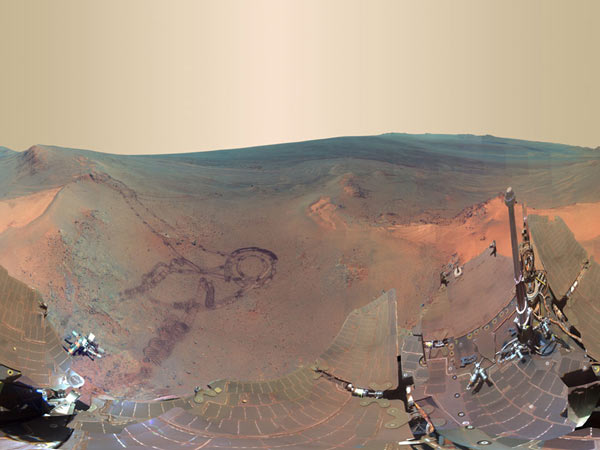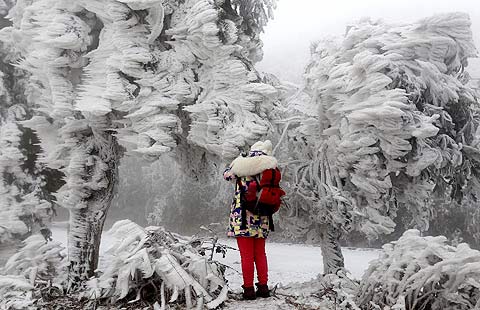NASA finds clues to possible water flows on Mars
Updated: 2014-02-11 08:53
(Agencies)
|
|||||||||||
 |
|
A 360-degree digitally-compressed panorama image of Mars is seen in this composite of 800 images sent from the NASA Opportunity rover on Mars released on July 9, 2012.[Photo/Agencies] |
WASHINGTON - US space agency NASA said Monday its Mars Reconnaissance Orbiter and Odyssey orbiter have sent back clues that liquid water may still exist today on the Red Planet.
The spacecraft spotted "dark, finger-like markings" that advance down some Martian slopes when temperatures rise, as well as corresponding seasonal changes in iron minerals on the same slopes, NASA said.
One suggested explanation for the phenomenon is that "brines with an iron-mineral antifreeze," like ferric sulfate, could flow seasonally on parts of Mars, it said.
Researchers call these dark flows "recurring slope lineae (RSL) " and so far they have found 13 confirmed RSL sites on Mars, according to the space agency.
"We still don't have a smoking gun for existence of water in RSL, although we're not sure how this process would take place without water," said Lujendra Ojha, lead author of two reports published in the journals Geophysical Research Letters and Icarus.
Although the team did not find any spectral signature tied to water or salts, they did find distinct and consistent spectral signatures of ferric and ferrous minerals at most of the confirmed RSL sites.
The researchers said these iron-bearing minerals were more abundant or featured distinct grain sizes in RSL-related materials as compared to non-RSL slopes.
"Just like the RSL themselves, the strength of the spectral signatures varies according to the seasons. They're stronger when it's warmer and less significant when it's colder," Ojha said.
One possible explanation for these changes is a sorting of grain sizes, such as removal of fine dust from the surface, which could result from either a wet process or dry one, the researchers said.
Other explanations could be an increase in the more-oxidized component of the minerals, or an overall darkening due to moisture. Either of these would point to water, even though no water was directly detected, they noted.
The researchers also compared new observations with images from previous years, revealing that RSL are much more abundant some years than others.
Related Stories
NASA launches robotic explorer to Mars 2013-11-19 08:01
India's Mars Orbiter raised to over 100,000 km 2013-11-12 14:02
Near-constant surprises of Mars 2013-10-13 08:25
India unveils Mars mission spacecraft 2013-09-12 16:21
Today's Top News
Joint operation ensnares poachers
China's largest private charity elects new chiefs
Action needed to halt bird flu, experts warn
French president coming alone to White House
Geneva II talks resume over Syria
UN agency says Iran probe needs more work
Giraffe shot and dismembered in Copenhagen Zoo
Minimum alcohol price would save UK lives
Hot Topics
Lunar probe , China growth forecasts, Emission rules get tougher, China seen through 'colored lens', International board,
Editor's Picks

|

|

|

|

|

|





